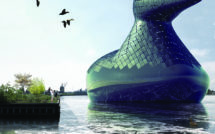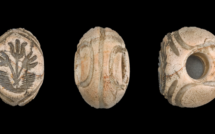

An introduction to our special feature, Sustainable European Cities and Digitization.
Sustainable development is not only key to political discourses and journalism, but it is also gaining traction with innovative approaches in academia, where the climate humanities combine their methodological rigor to turn scientific knowledge into social action and community engagement. On a global level, the sustainable development goals to end poverty and gender discrimination and to increase economic growth were adopted by all United Nations member states.[1] Among its seventeen goals, the sustainability of the environment plays a significant role. Underlying all of this is the suggestion that environmentalism is not only one of the “extras” to be added on to other desiderata of economic and social development, but that sustainability should underpin all human endeavor. Just recently, the President of the European Commission, Ursula von der Leyen, called for a European Bauhaus der Erde, a green movement to transform the “built environment” through bottom-up initiatives that involve artists, architects, and communities alike, thereby creating a shared vision “based on the principles of sustainability, participation and aesthetics.”
Almost in tandem with the general drive towards a planetary consciousness, and with the notion that social and environmental challenges are universal despite their local appearance, a distinct conceptualization of “place” also gained new relevance. From the 1990s on, placemaking has become a leading inquiry in urban research. Space—as it is understood—is transformed into place through human action. Placemaking is the process of reshaping space in order to make it more appealing and usable. In Europe and elsewhere, placemaking is a continuous and largely uninterrupted process, in which local agents (urban citizens, governments, and other actors) play an active role. Now, with the practical and ethical imperative of general sustainability, it faces new challenges. European cities need to investigate the processes that enable them to tend to sustainability; processes which equally involve citizen initiatives and cultural and social production, as well as legislative, economic, and technical measures. In the dense fabric of production of place within the European geographical and cultural space, the digital is an unmissable tool and agent. It plays an increasingly powerful role in recording and disseminating citizen contributions to knowledge production, and it is increasingly responsible for transforming and producing such knowledge for policy and public use.
This EuropeNow issue offers insights into developing the sustainability of European cities through a number of case studies of recent social and technological practices, while also foregrounding the role of the digital in modernization. The selection is much indebted to the work of two current COST Actions, which aim at developing research and innovation networks with the financial support of the European Commission. The COST Actions “Dynamics of Placemaking and Digitization in Europe’s Cities (CA-18204)” and “The Research Network of Including Geothermal Technologies into Decarbonised Heating and Cooling Grids (CA-18219)” might appear to have different disciplinary foci—while the former is sociological and architectural in orientation, the latter is explicitly technological and is rooted in applied science—their sharply divergent disciplinary backgrounds are brought together through their overlapping interests. Their synergies now find expression in EuropeNow through its transdisciplinarity that will not only enrich urban studies but demonstrate the very possibility of finding and creating productive synergies across disciplinary and geographical boundaries.
The articles below give account of contemporary European placemaking projects with a significant digital component. Pekka Tuominen introduces us to finances in his analysis of participatory budgeting in Helsinki. In the Finnish capital, certain decisions about the municipal spending of money and resources are reached through a dialogue between various groups, including residents, and city administrators. Participatory budgeting and citizens’ active involvement in local authority-level financial decision-making is far from a new development; however, the example of Helsinki is particularly important because the author’s field work and participant observation allow us to view citizen involvement from close quarters. The article succinctly assesses the nature of the process. Suited to fit small-scale projects (improving a football field) rather than larger ones, the process needs further refinement for building inclusion of minority groups and for changing the focus from fierce competition to discussion and feedback. As the author argues, although “participatory budgeting is not a neutral tool that guarantees straightforward and equitable participation,” it is still an important arena where future guidelines of democracy are negotiated.
Ida Lange and Chrisann Neysa Rodrigues’s study compares the policies concerning the development of urban green spaces in two coastal cities with very dense urban environments: Copenhagen and London. Green spaces are widely known to have beneficial influence in terms of the environment, economy, society, as well as individual psychology. Both cities introduced policies to serve sustainability by increasing green areas. Copenhagen follows a “green planning tool” (the green factor included in all publicly driven projects) and the goal of planting 100,000 trees. London attempts to improve its air quality by fostering low carbon economy. As the authors suggest, the study of environmental policies in these two cities just represents an early step in a broader survey of local environmental policies, “and more research should be done on how to develop highly functional green areas in developed urban contexts with scarce availability of space, thereby identifying and creating best practice solutions.”
Clara Reich, Anna Bradley. and Adam Curtis guide us through some current European placemaking projects, which aim at improving the quality of everyday life through practices of citizen participation. Their focus is Placemaking Europe, the leading European network for connecting different localized projects on a comprehensive platform for simultaneous visibility. This platform, which aspires to be a clearing house for long-term projects, introduces a selection, including PlaceCity: Placemaking for Sustainable and Thriving Cities,[2] which examines Vienna and Oslo as comparative case studies to research, test, and empower resilience strategies. The Nabolagshager Project introduces a social enterprise in Oslo which focuses on grass-roots community engagement and the Toolbox, an open-source creative commons resource, offers practical guidance on how placemaking strategies can be replicated all over Europe.
The digital domain is central to these sustainability and participatory developments, whereas the Finnish project relies on digital communication during the discussions and deliberations of budgeting. Although platform-based conversations cannot replace real-life dialogues in the course of these exchanges, the digital still remains essential in discussions and dissemination. The Toolboox in Placemaking Europe is specifically designed for distributing methodological and pedagogical tools that enable the expansion of the movement towards participatory and democratic placemaking. In addition to interconnectivity, the Toolbox also acts as a historical archive to understanding changing trends and progress made, thereby professionalizing the field of placemaking by hosting a consolidated collection of resources.
Our Campus Spotlight on Columbia University further highlights pedagogical innovation and digitization by focusing on the origin, development, and present state of university collections. Parallel Heritages, Humanities in Action, led by Holger A. Klein and Alain Duplouy, reveal the benefits of such collections, their tangible heritage within city landscapes, and the role that archaeological objects play in educating and training the next generation of art historians and archaeologists in the United States and Europe. In her interview “Parallel Thoughts” with Roberto C. Ferrari, Maria Dimitropoulos provides an overview of the study of collections and the rejuvenated interest in object-centered learning, issues that are further solidified by Monica Bulger’s “The Search for the Origins of the Argive Fragments in Columbia’s Young Collection,” as well as by the research of Majdolene Dajani and Erhan Tamur’s “New Impressions and Future Directions: Columbia University’s Collection of Ancient Western Asian Seals,” where the authors argue the importance of collections for curricular developments and artistic methods.
The second cluster of articles concerns the most specific and more scientific perspective of geothermal heating and cooling networks for green and liveable urban transformations. Green transformations of society and sustainability are inseparably connected to scientific processes of decarbonizations and circular economies: the heating and cooling of buildings are responsible for almost 50 percent of the final energy consumption and more than 25 percent of the overall greenhouse gas (GHG)emission, but currently only 19 percent of the energy consumption for this use in Europe is generated by renewable energy. The research described by Gregor Götzl focuses on using the relatively easily-available geothermal energy for heating and cooling buildings. The COST Action Geothermal-DHC sets out to provide a roadmap towards the better integration of geothermally supplied heating and cooling networks in Europe, aiming to show the way towards reaching the target of 50 percent of use of geothermal energy in district heating networks by 2050.
Geothermal energy, argues the second scientific article by Kai Zosseder, is also low on Co2 emissions. Therefore, the COST Action Geothermal-DHC explores examples of good practice for implementing geothermal energy for heating and cooling in different European cities. Munich is a European vanguard on large scale geothermal district heating and cooling, as it can take advantage of the energy resources offered by the South German Molasse-Basin. The use of geothermal energy in Munich can be compared with the geothermal district heating network in Bogatic, central Serbia, which uses geothermal reservoir of water in the temperature range of 75-80 ℃. Each of these good practice examples showcase the wide range of use of geothermal energy with different geothermal technologies, under different conditions and in different scales but with the same aim: to cover the heating and cooling demand in a climate-friendly way and to reduce CO2-emmisions for a green urban transformation supported by active stakeholder engagement.
Renewable energy can be beautiful, as the Land Art Generator (LAGI) Open Call Competitions proves, where international designs meet renewable energy solutions, making place and creating urban space. Ultimately, these creative undertakings enrich the city landscape as works of public art, spanning cities across the globe, from Copenhagen to Abu Dhabi to Santa Monica, among them the 2014 winning project “Solar Hourglass.” Baseline requirements are that the “artwork is to capture energy from nature, cleanly convert it into electricity, and transform and transmit the electrical power to a grid connection point to be supplied by the city.”
Research
- “Urban Green Spaces: Combining Goals for Sustainability and Placemaking” by Ida Sofie Gøtzsche Lange and Chrisann Neysa Rodrigues
- “The Quest for Efficient Deliberation and Proximity Democracy: The Case of Participatory Budgeting in Helsinki” by Pekka Tuominen, Mikko Rask, and Titiana Ertiö
- “Digital Placemaking Tools Propel Sustainable Urban Development beyond Temporary Interventions” by Anna Louise Bradley, Clara Julia Reich, and Adam Curtis
- “Geothermal Heating and Cooling Networks for Green and Livable Urban Transformations – Part I”
- “Geothermal Heating and Cooling Networks for Green and Livable Urban Transformations – Part II”
Visual Art
Campus Spotlight: Columbia University
- Introduction by Holger A. Klein and Alain Duplouy
- “Parallel Thoughts: A Conversation about Columbia University’s Art Properties Collection and the Educational Experience” by Maria Dimitropoulos
- “New Impressions and Future Directions: Columbia University’s Collection of Ancient Western Asian Seals” by Majdolene Dajani and Erhan Tamur
- “The Search for the Origins of the Argive Fragments in Columbia’s Young Collection” by Monica Bulger
- “The Antefix in Art Properties: Van Buren’s Gift” by Joseph Woldman
Editor’s Pick
Nicole Shea is the Chair of COST Action 18204 and guest researcher at the Georg Simmel Center for Metropolitan Studies, Humboldt University. She is also the Director of the Council for European Studies and Executive Editor of EuropeNow. Her current research focuses on placemaking practices through the lens of the climate humanities.
Zsuzsanna Varga is Vice-Chair of COST Action 18204. She teaches Hungarian Studies at the University of Glasgow, where she also acts as Chief Adviser of Studies (College of Social Sciences). She has published widely on Hungarian film and literature from a comparative perspective (The Worlds of Hungarian Writing, 2016, Reflections in the Library, 2017 and Popular Cinemas in East Central Europe). Her current research focuses on the representation of the urban in travel writing and literary text, with special regard to the operations of 19th East Central European cultural capitals.
We would like to thank the European Commission, our Working Group Leaders, and the members of our COST Actions for their dedication, persistence and excellent contributions towards placemaking and sustainability in European cities. The work presented here is the result of our combined 18-months-long research.
References
[1] UN (2015) Sustainable Development Goals. [Online] Available at: [Accessed 3 May 2021]. https://www.undp.org/content/undp/en/home/sustainable-development-goals.html The importance of urban sustainability is articulated in the UN Sustainability Goal number 11: Sustainable cities and communities.
[2] PlaceCity is supported by JPI Urban Europe under the Making Cities Work Call and funded by FFG Austria and The Research Council of Norway. https://jpi-urbaneurope.eu/projects/, (accessed in April 2021) ; https://placemaking-europe.eu/consortium-placecity/ , (accessed in April 2021).
Photo: Bosco Verticale, the innovative architecture design | Shutterstock
Published on May 11, 2021.




